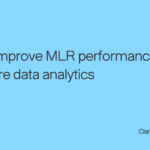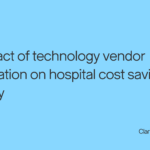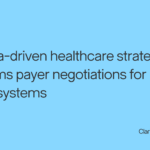As the largest not-for-profit healthcare system in the Houston area — with about 33,000 employees, 6,600 physicians, and 260 care delivery sites, including 11 hospitals — Memorial Hermann Health System generates plenty of data. But what does the system do with all that data? Since 2020, Memorial Hermann has collaborated with Clarify Health to leverage claims-level insights for market share analysis, physician outreach, cost management, and quality utilization. During a recent session at the American Association for Physician Leadership (AAPL) conference, Memorial Hermann’s Jessica Bright said that working with Clarify is about improving physicians they already have in their network and partnering with new providers that can bring high-quality, low-cost volume into the organization. As the director of business development for Memorial Herman’s primary care service line, Bright added that their efforts are all about smart growth, not just straight volume. Clarify’s data and analytics platform is uniquely suited for a health system like Memorial Hermann. “Our big talking point is that we have a lot of data … 300 million American lives are covered under our data,” said John Barzydlo, Clarify’s Vice President of Customer Success who presented alongside Bright at the AAPL event. Most of that data is longitudinal, tracking from diagnosis to cure — which allows organizations like Memorial Hermann to know precisely when patients leave and re-enter the system. Bright and Barzydlo discussed how Clarify helps Memorial Hermann build its strategic goals, drive growth, and improve health outcomes for patients. The Memorial Hermann – Clarify partnership focuses on capturing market share while partnering with physicians who are driven by data to achieve their strategic goals. The Memorial Hermann team does this by using data analytics to understand physician performance, adjusting strategies based on those insights, and refining their approach to physician engagement. Memorial Hermann built a solution using Clarify Performance to extract the data the health system needs to target and bring in certain kinds of physicians. Over the past year, Bright and her colleagues have executed these data-driven strategies with impressive results. “When we look at the service-line specific work we do as business development directors — it’s myself and I have four counterparts — I can’t claim all of these successes for myself,” Bright noted. “We have a really integrated team that works together. But when you boil down our work and what we do on a daily basis, it really falls into four different focus areas to help us grow that PCP volume.” The first area of focus is improving alignment within the health system’s tiered networks; in other words, it’s about how Memorial Hermann helps physicians already in its network improve quality of care and add value to the organization. The second focus is on increasing partnerships, and the third is improving cost efficiency and quality by employing high quality, low-cost providers that generate great clinical outcomes. The last focus area, Bright noted, is reducing leakage, by trying to get Memorial Hermann’s physicians to keep referrals within a defined specialty network.” Clarify provided the Memorial Hermann team with several powerful tools that include market and referral analytics, performance scorecards, and internal analytics. “We have lots of data at our fingertips,” Bright noted. “We go into this daily and look at our granular data,” Bright said. “It really helps us dig in and understand what’s happening in our market.” The Markets and Referrals tool provides physician-level data such as a doctor’s volume of patients and appointments, to whom the doctor sends referrals, and their most highly referred-to specialties. Clarify Performance empowers the Memorial Hermann team to analyze physician scorecards which feature metrics such as quality ratings, costs, and efficiency — even on providers that aren’t already a part of its health system. “That gives us really great insights we don’t have internally because a lot of these physicians are not employed by us,” Bright explained. The Clarify team creates a slide deck of data for Memorial Hermann once a quarter. The presentation includes service-line level detail on where in-network physicians refer patients, and the quality and cost of care of those specialty providers. With those insights, the health system can focus its recruitment efforts on the best specialists. These quarterly updates also help the Memorial Hermann team identify and celebrate its successes. The business development team distills those insights into simple, layperson-friendly graphs and reports for senior executives and the organization’s CEO. On a day-to-day basis, Memorial Hermann drives strategic growth by monitoring market size, potential growth areas, successful initiatives it can replicate, and volume of performance — “so we can set the stage for where we want our strategy to go,” Bright explained. This area involves three main data elements: which service lines require the most attention, where to focus efforts over the next quarter, and trend reporting. “We want to know [whether] this dip is something that’s happening once, [if it’s] a blip on the radar, if it’s a quarter over quarter improvement,” Bright said. “We can determine what we need to address.” On a daily basis, Bright and her team are talking with its physicians, figuring out where the barriers are and using the data to have the most productive and efficient conversation to help drive those results. Segmenting specialties by performance-based measures helps Memorial Hermann identify which physicians would be the best partners. “We want physicians who are going to bring the most value to our organization, especially as medicine is moving more towards value-based care in a lot of markets,” noted Bright. Memorial Hermann categorizes physicians into four tiers based on referral percentages and quality metrics, with tier one representing the best quality and cost-effectiveness. This internal tiering allows the business development team to focus its efforts on the providers most likely to align with the health system’s organizational goals, prioritize resources effectively, and strategize both engagements and interventions with physicians. Bright pointed out that this system also helps them prioritize where they‘re going to spend their time.“ We all know there’s always work waiting for the next day. We can never get to all of it, and we certainly can’t get to all of the primary care providers (PCPs). So, it helps us prioritize the biggest bang for our buck.” On Clarify’s side, Barzydlo says it’s critical that their tools measure a physician’s performance accurately — because Memorial Hermann holds them accountable and then changes the tiering of how they prioritize outreach with those physicians.“ PCPs are the quarterbacks for healthcare. They’re the ones that drive the cost.” Barzydlo notes that costs are exploding in the U.S. year over year at an exponential rate, so it’s critical to ensure that PCPs are measured appropriately and are keeping patients healthy. That includes benchmarking the metrics Memorial Hermann uses to denote physician performance. Clarify used 600 data points to measure quality and assigned each doctor a score from zero to 150. The highest score means the physician is “dead-on accurate,” compared with the benchmark. But any score above 50 can be read as “outperforming,” while scores below 50 suggest improvement is necessary. “In the last year and a half or so, we have really taken these data analytics to a new level and started using them to pinpoint how we’re going to be the most impactful,” Bright said. In this time, Memorial Hermann grew its tier one physician group by 26%. That means the organization can move the third- and second-tier providers up — a rising tide lifts all boats. “We always want to see those providers moving up a tier,” she said. “That means they’re working with us, and they are invested in the route we’re going in, the strategy we’ve set.” And although Memorial Hermann’s average “keep it” rate the rate at which patients stay with physicians started somewhere in the fifties according to Bright, the average grew to 67% since the Clarify partnership began. The number of new patients that entered the health system via physician referrals grew by 5%. What is more, Memorial Hermann brought on 39 physicians over the last year, just based on using this data to bring the right physicians into Memorial Hermann’s network. Bright notes the system can also boast a 9% decrease in cost and about a 4% increase in quality for the PCPs it targets. “What does that mean?” she asked. “If we say $20,000 is the average cost of care for an individual in the United States — which is insanely expensive — [with] a 9% change, multiplied by even 1,000 patients, you’re into the millions of dollars that you are saving an organization. It’s not about reducing the footprint of that patient in the health system, but it’s about bringing them in when it is needed and keeping them loyal.” Effective use of data analytics can significantly improve strategic decision-making in healthcare. Here are the action items Bright and Barzydlo recommended for healthcare system business development teams: “We’re all in healthcare to make it better in some way, shape, or form,” Barzydlo said. “We’re doing it in our own ways, but at the end of the day we want patients to be healthier, and we want them ideally to stay out of the hospital while maintaining the margins at a health system level.” Partnership goals and data utilization
Strategic goals and implementation
Healthcare analytic tools
Clarify Markets and Referrals
Clarify Performance
Clarify data analytics
A closer look at the data
Market size
Physician engagement
Performance alignment
Physician engagement and tiering system
Results and performance metrics
The power of data analytics
- Author Details





